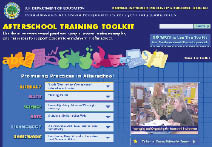The award-winning
 |
|
The toolkit includes ideas for activities in the arts … |
Afterschool Training Toolkit is an online portal to free, high-quality professional training tools and resources. It emphasizes making learning fun through activities that increase literary, math, science, arts, technology and homework skills.
Target Audience
After-school project directors, site coordinators and instructors.
Produced By
The National Partnership was launched in 2003 to build academic enrichment into after-school programs, in response to academic standard and accountability measures initiated by the No Child Left Behind Act. It is funded through the U.S. Department of Education’s 21st Century Community Learning Center program.
 |
The seven partners are SEDL (formerly the Southwest Educational Development Laboratory), in Austin, Texas; the National Center for Research on Evaluation, Standards and Student Testing, at UCLA; the Mid-Continent Research for Education and Learning, in Denver; the Northwest Regional Educational Laboratory in Portland, Ore.; the Southeast Regional Educational Laboratory at the University of North Carolina at Greensboro; the U.S. Department of Education; and the WGBH Educational Foundation in Brighton, Mass.
 |
|
… and technology |
Uses
The toolkit is intended to show the value of academic enrichment in after-school programs, which best practices show evidence of positive academic outcomes, and how to replicate research-identified best practices with fidelity. Toward that end, the toolkit provides a page devoted to “10 Ways to Use this Toolkit for Professional Development.”
The training sessions take from 15 to 30 minutes each. They include instruction on understanding the theories behind the best practices and staff members’ roles in their use; structuring discussions to incorporate new knowledge into existing activities; developing and practicing a planned activity; and determining how to improve, refine or extend the activity.
Tools
The main feature of the toolkit’s home page is a pull-down menu offering “shortcuts” to several promising practices in each area that employ ways to embed academic content into enrichment activities. Those best practices include:
• Literacy: Book discussion groups and literacy circles; story and literature dramatizations.
• Math: Finding math in every-day problems; using manipulatives and other math tools.
• Science: Investigating science through inquiry; exploring science through projects and problems.
• Arts: Expressing yourself through the arts; making connections to history and culture.
• Technology: Gathering and sharing information; learning in virtual spaces.
• Homework Help: Managing and organizing the homework environment; tutoring, mentoring and building study skills.
Clicking on a best practices link takes users to a multi-page package, with one tap each for:
• Practice in Action – What the practice is, what staff members do, and why the practice works.
• Planning Your Lesson – Printable lesson planning templates that help staff see how the practice fits into their own programs.
• Sample Lessons – At least three complete lesson plans for specified grade ranges that include a list of needed materials, information on how to prepare for the session and exactly how to carry out the activities with the students.
• Resources – Tips on how to incorporate simple and advanced technology tools – such as graphing calculators in a math exercise – and web and text resources.
In addition, home pages for each of the six knowledge areas present principles, key elements and considerations for incorporating that area’s content into a high-quality after-school program. For example, the “Literacy” home page discusses the importance of “real-world” literacy activities that can “engage reluctant readers with directions for cooking, carpentry or games,” by writing about a field trip experience, or by interviewing members of their community.
The six knowledge area home pages also offer links to support materials, including a glossary of “Key Terms,” national “Standards Refreshers,” a lesson-planning rubric based on the “Five Es” (engage, explore, explain, extend and evaluate) and a “Literature Review” that summarizes the body of research on best practices and outcomes in that knowledge area. They again provide the links to all featured best practices for that knowledge area, and include a 15- to 30-second video clip embedded at the top of the home page that presents a brief overview of one of those best practices.
Users can access longer three- to nine-minute documentary-style video clips of all 26 best practices featured on the site by clicking on links on the pages. A “Technical Help” area at the bottom of the toolkits home page provides links to free downloads of any applications needed to navigate the site fully, such as Flash, QuickTime, Windows Media Player and Adobe Reader.
Most Valuable Tool
The video vignettes of the best practices identified in the study and featured on the toolkits website come from actual after-school programs that participated in the study. They answer a common question for youth agencies reading about best practices research: “What does that look like on the ground?” The inspiring videos viscerally demonstrate the positive outcomes that can result from the successful integration of academic enrichment in after-school programs: a child’s pride in accomplishment, rapport between adults and youth, teamwork among peers, a student’s expanded vocabulary, and demonstrations of new knowledge.
Additionally, an unobtrusive “Credits” link found only at the bottom of the toolkit’s home page provides contact information for the content developers in each of the knowledge areas. That’s a potentially valuable resource for any after-school practitioners or funders with questions or support needs.
Also, partnership staffers are available to provide training to after-school professionals on the use of the Afterschool Training Toolkit, according to SEDL spokeswoman Laura Shankland.
Evidence-Based
The toolkit is based on research. In 2004, the National Center for Research on Evaluation, Standards and Student Testing began a four-year national study of 54 after-school programs with evaluation data, so that it could identify after-school sites that showed evidence of success in increasing academic achievement in literacy, math, science, arts, technology and homework skills. Researchers analyzed data from the sites, interviewed students, teachers and professionals involved in the programs, and visited the sites to observe the programs in action.
That study, as well as the expertise and research synthesis provided by the partnership’s members, formed the comprehensive literature reviews accompanying each of the knowledge areas. Additional literature reviews in some of the knowledge areas focus on the special needs of English language learners.
Outcomes
The Afterschool Training Toolkit’s videos won two awards in 2008: a CINE Golden Eagle Award and a certificate of merit in the 43rd International Communications Video & Interactive Media Competition. Also in 2008, the partnership’s e-newsletter, AfterWords, won the Distinguished Achievement Award from the Association of Educational Publishers.
The final version of the Afterschool Training Toolkit was first made available online in July, said Shankland at SEDL. In August, the toolkit had more than 30,000 hits on its website.
Contact
Laura Shankland, SEDL, laura.shankland@sedl.org, (512) 391-6556.






























